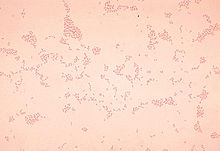Actinobacillus suis
| Actinobacillus suis | |
|---|---|
 |
|
| Actinobacillus suis | |
| Scientific classification | |
| Kingdom: | Bacteria |
| Phylum: | Proteobacteria |
| Class: | Gammaproteobacteria |
| Order: | Pasteurellales |
| Family: | Pasteurellaceae |
| Genus: |
Actinobacillus Brumpt 1910 |
| Species: | Actinobacillus suis |
Actinobacillus suis is a beta-haemolytic, Gram-negative bacterium of the Pasteurellaceae family.
The bacterium has many strains and is the pathogen responsible for Actinobacillosis in pigs of all ages. It can also infect wild birds, domestic ruminants, dogs, cats and horses.
The organism can be found in the respiratory tract and tonsils of both infected and healthy pigs that act as carriers. Transmission is via the respiratory tract and piglets are usually infected early on in life.
Herds with a high health status are more at risk and outbreaks can be explosive.
Affected piglets can develop septicaemia, multifocal infections, respiratory signs, and may die.
Adult pigs may show signs relating to pneumonia, lethargy, anorexia, skin lesions similar to Erysipelas and sudden death.
Diagnosis relies on the culture of sampled tissues to isolate the organism.
Signs and necropsy findings may mimic diseases such as: Erysipelas, Glasser's Disease, and Actinobacillus pleuropneumoniae.
Antibiotics such as ceftiofur, gentamicin and trimethoprim/sulfadiazine are effective in treating the disease if diagnosis is rapid enough.
Biosecurity measures should be strictly followed in herds, including adequate quarantine time, testing and disinfection protocols.
...
Wikipedia
